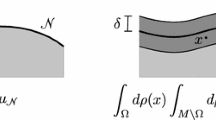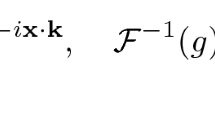Abstract
Causal variational principles, which are the analytic core of the physical theory of causal fermion systems, are found to have an underlying Hamiltonian structure, giving a formulation of the dynamics in terms of physical fields in space-time. After generalizing causal variational principles to a class of lower semi-continuous Lagrangians on a smooth, possibly non-compact manifold, the corresponding Euler–Lagrange equations are derived. In the first part, it is shown under additional smoothness assumptions that the space of solutions of the Euler–Lagrange equations has the structure of a symplectic Fréchet manifold. The symplectic form is constructed as a surface layer integral which is shown to be invariant under the time evolution. In the second part, the results and methods are extended to the non-smooth setting. The physical fields correspond to variations of the universal measure described infinitesimally by one-jets. Evaluating the Euler–Lagrange equations weakly, we derive linearized field equations for these jets. In the final part, our constructions and results are illustrated in a detailed example on \(\mathbb {R}^{1,1} \times S^1\) where a local minimizer is given by a measure supported on a two-dimensional lattice.

Similar content being viewed by others
Notes
The connection to jets in differential geometry (see for example [17]) is obtained by considering real-valued functions on \(\mathscr {F}\). Then their one-jets are elements in \(C^\infty (\mathscr {F}) \oplus \Gamma (\mathscr {F}, T^*\mathscr {F})\). Identifying the cotangent space with the tangent space gives our jet space \(\mathfrak {J}\).
References
Bernard, Y., Finster, F.: On the structure of minimizers of causal variational principles in the non-compact and equivariant settings. Adv. Calc. Var 7(1), 27–57 (2014). arXiv:1205.0403 [math-ph]
Bogachev, V.I.: Measure Theory, vol. I. Springer-Verlag, Berlin (2007)
Deligne, P., Freed, D.S.: Classical field theory. quantum fields and strings: a course for mathematicians, Vol. 1 (Princeton, NJ, 1996/1997), Am. Math. Soc., Providence, RI, pp. 137–225 (1999)
Finster, F.: Perturbation theory for critical points of causal variational principles. arXiv:1703.05059 [math-ph]
Finster, F.: Causal variational principles on measure spaces. J. Reine Angew. Math. 646, 141–194 (2010). arXiv:0811.2666 [math-ph]
Finster, F.: The continuum limit of causal fermion systems. Fundamental theories of physics, vol. 186, Springer, (2016). arXiv:1605.04742 [math-ph]
Finster, F., Grotz, A.: A Lorentzian quantum geometry. Adv. Theor. Math. Phys. 16(4), 1197–1290 (2012). arXiv:1107.2026 [math-ph]
Finster, F., Grotz, A., Schiefeneder, D.: Causal fermion systems: a quantum space-time emerging from an action principle. In: Finster, F., Müller, O., Nardmann, M., Tolksdorf, J., Zeidler, E. (eds.) Quantum Field Theory and Gravity, pp. 157–182. Birkhäuser Verlag, Basel (2012). arXiv:1102.2585 [math-ph]
Finster, F., Kleiner, J.: Quantum effects and collapse for causal variational principles. (in preparation)
Finster, F., Kleiner, J.: Causal fermion systems as a candidate for a unified physical theory. J. Phys. Conf. Ser. 626, 012020 (2015). arXiv:1502.03587 [math-ph]
Finster, F., Kleiner, J.: Noether-like theorems for causal variational principles. Calc. Var. Partial Differ. Equ. 55:35(2), 41 (2016). arXiv:1506.09076 [math-ph]
Finster, F., Schiefeneder, D.: On the support of minimizers of causal variational principles. Arch. Ration. Mech. Anal. 210(2), 321–364 (2013). arXiv:1012.1589 [math-ph]
Finster, F. et al.: The quantum field theory limit of causal fermion systems. (in preparation)
Halmos, P.R.: Measure Theory. Springer, New York (1974)
Helgason, S.: Groups and geometric analysis. Mathematical surveys and monographs, vol. 83, American Mathematical Society, Providence, RI, Integral geometry, invariant differential operators, and spherical functions, Corrected reprint of the 1984 original (2000)
Rudin, W.: Real and Complex Analysis, 3rd edn. McGraw-Hill Book Co., New York (1987)
Saunders, D.J.: The Geometry of Jet Bundles, London Mathematical Society Lecture Note Series, vol. 142. Cambridge University Press, Cambridge (1989)
Acknowledgements
We would like to thank Niky Kamran and Olaf Müller for helpful discussions on jet spaces and Fréchet manifolds as well as Jordan Payette and the referee for valuable comments. We are grateful to the Center of Mathematical Sciences and Applications at Harvard University for hospitality and support. J.K. gratefully acknowledges support by the “Studienstiftung des deutschen Volkes.”
Author information
Authors and Affiliations
Corresponding author
Additional information
Communicated by J. Jost.
Appendix: The Fréchet manifold structure of \({\mathcal {B}}\)
Appendix: The Fréchet manifold structure of \({\mathcal {B}}\)
As in Sect. 3 we assume that \(\mathscr {F}\) is a smooth manifold of dimension \(m \ge 1\). We want to endow the set \({\mathcal {B}}\) with the structure of a Fréchet manifold. The first step is to specify the topology on the set \({\mathcal {B}}\) in (3.7). We choose the compact-open topology defined as follows. First, parametrizing the measures according to (3.6) by a pair \((f, F) \in C^\infty (\mathscr {F}, \mathbb {R}) \times C^\infty (\mathscr {F}, \mathscr {F})\), we can identify \({\mathcal {B}}\) with a subset of the space of such pairs,
Our task is to endow the sets \(C^\infty (\mathscr {F}, \mathbb {R})\) and \(C^\infty (\mathscr {F}, \mathscr {F})\) with the structure of a Fréchet manifold. Once this has been accomplished, the Fréchet structure on \({\mathcal {B}}\) can be introduced simply by assuming that \({\mathcal {B}}\) is a Fréchet submanifold of the product manifold \(C^\infty (\mathscr {F}, \mathbb {R}) \times C^\infty (\mathscr {F}, \mathscr {F})\).
Being a vector space, the space \(C^\infty (\mathscr {F}, \mathbb {R})\) can be endowed even with the structure of a Fréchet space. To this end, on \(\mathscr {F}\) we choose an at most countable atlas \((x_\lambda , U_\lambda )_{\lambda \in \Lambda }\) (with an index set \(\Lambda \subset \mathbb {N}\)) whose charts \(x_\lambda : U_\lambda \rightarrow \mathbb {R}^m\) are defined on relative compact subsets \(U_\lambda \subset \mathscr {F}\). We then consider the Fréchet topology induced by the \(C^k\)-norms in these charts, i.e.
The resulting topology is metrizable. It is induced for example by the distance function
In order to endow \(C^\infty (\mathscr {F}, \mathscr {F})\) with the structure of a Fréchet manifold, we work locally in a neighborhood of a point \(F \in C^\infty (\mathscr {F}, \mathscr {F})\). First, we refine the previous atlas \((x_\lambda , U_\lambda )\) in such a way that the domains \(U_\lambda \) are all convex geodesic neighborhoods with respect to a chosen Riemannian metric g on \(\mathscr {F}\). Moreover, we further refine this atlas to a new atlas \((y_\gamma , V_\gamma )_{\gamma \in \Gamma }\) in such a way that F maps the domains of the new charts to domains of the old charts, meaning that for every \(\gamma \in \Gamma \) there is \(\lambda (\gamma ) \in \Lambda \) such that
(for example, one can choose the domains of the new charts as open subsets of the sets \(U_\lambda \cap F^{-1}(U_\nu )\) for \(\lambda , \nu \in \Lambda \) and introduce the charts as the restrictions of \(x_\lambda \) to the new domains). We restrict attention to mappings G which are so close to F that they map to the same charts, i.e.
For such mappings, we can define the \(C^k\)-norms by
The resulting Fréchet topology is again metrizable, as becomes obvious for example by setting
It remains to construct a local chart around F. To this end, it suffices to consider mappings G which satisfy (5.12). Then, since the domains of the charts \(U_\lambda \) are all geodesically convex, for any \(x \in \mathscr {F}\) there is a unique vector \(v(x) \in T_{F(x)} \mathscr {F}\) with the property that \(G(x) = \exp _{F(x)} v(x)\). In this way, the mapping G can be described uniquely by a vector field \(v \in C^\infty (F(\mathscr {F}), T\mathscr {F})\) on \(\mathscr {F}\) along \(F(\mathscr {F})\). The mapping \(G \rightarrow v\) is the desired chart, taking values in the linear space \(C^\infty (F(\mathscr {F}), T\mathscr {F})\).
For clarity, we finally explain what the tangent vectors of \({\mathcal {B}}\) are, how these tangent vectors act on functions, and how these derivatives are related to the derivative \(\nabla _{\mathfrak {u}}\) as defined in (3.4). These elementary facts are also needed for the computation of the exterior derivative \(d\gamma \) in the proof of Lemma 3.4. Given \(\mathfrak {v}=(b,v) \in T_\rho {\mathcal {B}}\), we let \(\tilde{\rho }_\tau \) be a smooth curve in \({\mathcal {B}}\) with \(\tilde{\rho }_\tau |_{\tau = 0}=\rho \) and \(\dot{\rho }_\tau |_{\tau =0} = \mathfrak {v}\). We again write the measures \(\tilde{\rho }_\tau \) in the form (3.10) (see Lemma 3.2), so that (3.11) holds. Then the directional derivative of a smooth function \(\phi \) on \({\mathcal {B}}\) is defined as usual by
In particular, the derivative of \(\gamma (\mathfrak {u})\) as defined in (3.21) is given by
We point out that here the derivative \(\nabla _{\mathfrak {v}(y)}\) also acts on the jet \(\mathfrak {u}\) in the derivative \(\nabla _{2,\mathfrak {u}}\). The commutator of such products of derivatives can be computed with the help of the following lemma.
Lemma 5.10
For \(\mathfrak {u}, \mathfrak {v}\in T_\rho {\mathcal {B}}\), we have
Proof
Again denoting \(\mathfrak {u}=(a,u)\) and \(\mathfrak {v}=(b,v)\), for any smooth function \(\eta \) on \(\mathscr {F}\) we have
In order to compute the commutator \([\mathfrak {u}, \mathfrak {v}]\), we consider diffeomorphisms \(\Phi _\tau , \tilde{\Phi }_s : {\mathcal {B}}\rightarrow {\mathcal {B}}\) along the vector fields \(\mathfrak {u}\) and \(\mathfrak {v}\), i.e.
Then
Differentiating with respect to s and \(\tau \) at \(\tau =s=0\) gives
Likewise, exchanging the two diffeomorphism gives the vector \(\mathfrak {v}\mathfrak {u}\rho \). Hence
This shows that
Comparing with (5.15) and the definition of \(\nabla _{\mathfrak {u}}\) in (3.4) gives (5.13).
We finally note for clarity that the minus sign in (5.16) arises because jets \(\mathfrak {u}, \mathfrak {v}\) act on functions on \({\mathcal {B}}\), whereas the derivatives \(\nabla _\mathfrak {u}\) and \(\nabla _\mathfrak {v}\) act on functions on M. When rewriting compositions of jets \(\mathfrak {u}\mathfrak {v}\) as compositions of derivatives on M, the order of the composition is interchanged to \(\nabla _v \nabla _u\). \(\square \)
Rights and permissions
About this article
Cite this article
Finster, F., Kleiner, J. A Hamiltonian formulation of causal variational principles. Calc. Var. 56, 73 (2017). https://doi.org/10.1007/s00526-017-1153-5
Received:
Accepted:
Published:
DOI: https://doi.org/10.1007/s00526-017-1153-5




